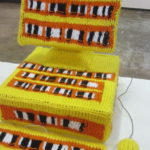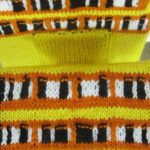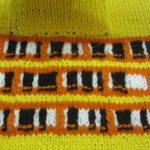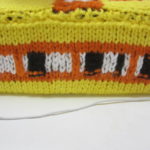Finalist, Fisher’s Ghost Art Award 2018
‘Binary Code for Ada Byron, Countess of Lovelace’ is a finalist in the Fishers Ghost Art Award in the Sculpture Section. Exhibition dates 3rd November 2018 to 13th December 2018. Opening Friday 2nd November 2018, 6 pm.
Artist’s Statement
A binary knitting pattern, plain/pearl-black/white covers a computer in binary code.
A clever woman‘s story told in woman’s’ craft language.
Q: Can you read the code?
A: Ada Lovelace, first computer programmer, code, Judy
01000001 01100100 01100001 said ’The Analytical Engine weaves algebraic patterns just as the loom weaves jacquard flowers and leaves’ 1843




Artist Statement
‘Binary Code for Ada Byron, Countess of Lovelace’
1 This binary code, textile installation celebrates the first computer programmer, Ada Byron, (the Countess of Lovelace).
2 Computer language is based on Binary Code. Binary numbers make use of only 2 characters, on and off, 1 and 0.
3 In a similar way knitting is a binary system based on 2 stitches, plain and pearl with combinations and variations of these 2.
4 I have translated text into binary code and developed a binary code knitting pattern using white for plain and black for pearl, covering a computer, monitor, keyboard and mouse.
5 Ada Lovelace, daughter of Lord Byron was the first computer programmer. She met inventor and mathematician Charles Babbage and watched him demonstrate a model portion of his difference engine when she was 17.
6 Ada published extensive notes about Charles Babbage’s Analytic Engine in 1843. She also translated an article written by an Italian military engineer into English about this theoretical analytical engine. Her notes, published in 1843, were 3 times as long as the original notes.
7 Ada who designed a flying machine when she was only 12 years old wrote of how this machine could be programmed with a code to calculate Bernoulli numbers, which some consider to be the first algorithm to be carried out by a machine and thus the first computer program.
“Supposing, for instance, that the fundamental relations of pitched sounds in the science of harmony and of musical composition were susceptible of [mathematical] expression and adaptations, the engine might compose elaborate and scientific pieces of music of any degree of complexity or extent.”
8 Ada’s contributions, originally published in 1843 weren’t recognised until a century after her death when republished by B.V. Bowden in 1953.
9 Walter Isaacson wrote that Ada “[made] the conceptual leap from machines that were mere calculators to the ones that we now call computers.”
10 Many women involved in the early days of science and computing have been largely written out of history. Six women originally programmed ENIAC, the first programmable computer in 1946, but when the computer made its debut in the press, they were not introduced.
‘The Analytic Engine weaves algebraic patterns just as the Jacquard loom weaves flowers and leaves.’ Ada Lovelace 1843
Judy Bourke February 2017
Ada Lovelace first computer programmer code Judy
01000001 01100100 01100001 01001100 01101111 01110110 01100101 01101100 01100001 01100011 01100101 01000110 01101001 01110010 01110011 01110100 00100000 01100011 01101111 01101101 01110000 01110101 01110100 01100101 01110010 00100000 01110000 01110010 01101111 01100111 01110010 01100001 01101101 01101101 01100101 01110010 01100011 01101111 01100100 01100101 01101010 01110101 01100100 01111001
Campbelltown Art Centre Exhibition info
